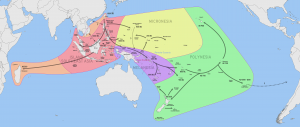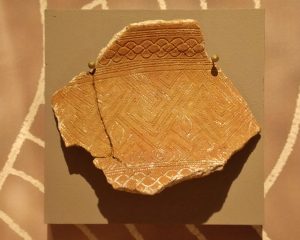15 Pacific Realm: Historical Geography I – Austronesian Expansion
“A map does not just chart, it unlocks and formulates meaning; it forms bridges between here and there, between disparate ideas that we did not know were previously connected.”
- Reif Larsen, American author
This chapter was written by an expert on this particular topic - Professor Alexander H. Bolyantz.
The Austronesian Expansion was perhaps the greatest human exploratory achievement until astronauts landed on the moon in 1969. Over the span of a few thousand years, oceangoing horticulturalists in open vessels sailed across hundreds of miles of open sea, and relying on courage, resolve, and not a little bit of luck, colonized islands across the Pacific Ocean.
In some of their voyages, these seafaring farmers encountered people whose ancestors had already been there for thousands of years — perhaps up to 50,000 years, as in the Philippines, Indonesia, and Melanesia. In other locations like Tahiti, New Zealand, and Hawai’i, these explorers were the first humans to ever occupy these lands.
Perhaps a bit paradoxically, the Austronesian (“southern island”) Expansion began north of the Equator, in what is now Southeast China around 5000 years ago (3000 BCE). This was when cultivators of rice, along with root crops like taro and yams (who spoke a language that linguists have partially reconstructed and call Proto-Austronesian) rowed across the 75-mile-wide Taiwan Strait and began farming on Taiwan.
From Taiwan, the diaspora moved south to the Philippines and then the islands of central Indonesia. By around 1400 BCE, the southbound expansion forked into a “right turn” heading west and a “left turn” heading east. The descendants of those who headed west sailed across the Indian Ocean and eventually colonized Madagascar, just off the southeast coast of Africa. Those whose ancestors took the “left turn” ended up discovering and settling many of the islands of the vast Pacific Ocean.

This “eastbound” group discovered and settled some of the islands of eastern Micronesia by perhaps as early as 2000 BCE (Guam) and, hundred of years later, Palau. (It is striking that the archaeological evidence points to these Austronesians on Guam long before they were on Palau. This would have required a voyage west from the Philippines to Guam across more than 1000 miles of open sea.)
Other “eastbound” groups veered more to the south. Tracking the progress of this branch of these Proto-Austronesian speakers and their descendants has been relatively straightforward. Many of them relied consistently on an easily recognizable form of pottery called Lapita, known for being decorated using something like a comb. This makes it easy for archaeologists to follow the Lapita “breadcrumbs” and track with some precision the timing and locations of the Austronesian presence from eastern Melanesia to Samoa between 1600 and 500 BCE.

Here is a photo of a fragment of Lapita pottery, as found in Musée Maritime in New Caledonia. By 1300 BCE, Lapita pottery could be found in much of the Bismarck Archipelago, and as far as the previously unpopulated islands of Fiji by 900 BCE and Samoa by 800 BCE. Also by 1300 BCE, rice-growing had ceased, with newfound crops such as New Guinea's breadfruit, coconut, and banana taking its place.
Using round numbers, these Proto-Austronesian-speaking sea-faring farmers had expanded nearly 5,000 miles in just over 2000 years. In the 2000 years starting with the discovery and settlement of the Samoan Islands, they would go nearly twice as far in about the same span of time. What accounted for the rapid acceleration of an already speedy—by human migration standards—expansion?
In short, it is the size of the islands. For much of the first half of the Austronesian Expansion, cultivators found themselves on relatively large islands (Taiwan is larger than Maryland; the biggest Philippine island—Luzon—is larger than Tennessee). So there was little need to expand to another island when there was so much room (relatively) on the island already occupied.
It is worth remembering that these Proto-Austronesian-speaking farmers did not see themselves as part of one of the grandest population shifts in human history. Rather, they were people like us who made the best decisions they could, based on the alternatives before them. And since they were farmers, the need for expansion was necessarily built in.
Imagine a farm, owned and operated by a family with two offspring. Each one inherits half of the family farm. A generation later, and again assuming two offspring each, the original family farm is now in quarters—a size that may not be enough to support a household. This means that somebody has to move on in order for the original farm to be sustainable. If a territory is large enough, a family moving on can pioneer a new plot of land not too far away. There could be a skirmish or two with local hunter-gatherers who don’t like the incursion, but the farmers have enough people behind them to win in the end. (Diamond, 1997, pp. 85–92. Of course, this is also the story of the westward expansion of mostly Europeans across the middle of North America.)
Still, even on large islands like Taiwan and Luzon—and later, the Bismarck Archipelago and the island chains of the Solomons and Vanuatu—eventually, the pressure to find another place to farm would be too much. And once the move to the much smaller islands of Micronesia beyond Guam and Polynesia beyond Samoa began, the need to find places to plant was accelerated.
As of 500 BCE, Many of the small Micronesian islands had been discovered and settled, even as far west as Kiribati. In general, Micronesia was settled before the Polynesian region; the earliest known Polynesian settlement was Tonga by around 900 BCE, followed by Samoa shortly after. The most distant Polynesian islands were discovered within a 500-year period—roughly 700–1200 CE, starting with the Cook Islands, Tahiti, and the Marquesas; then the Hawaiian archipelago (about 900 CE), and concluding with Rapa Nui (Easter Island) and New Zealand, just a few hundred years before Europeans arrived.
While some scholars disagree on the routes taken by these explorers, genetics (Li, et al, 2008; Yong, 2009) confirm the migratory account described here. Linguistically, cognates found in different Austronesian languages corroborate the same story:
Austronesian Expansion and Language
| Estimated Date of Austronesian Settlement |
Modern Language | hand | coconut | pig | woman | fish |
|---|---|---|---|---|---|---|
| 2250 BCE | Tagalog (Philippines) | limá | niyog | baboy | babae | isda |
| 1250 BCE | Malay | lima | nylur | babi | wanita | ikan |
| 1250 BCE | Sursurunga (New Ireland) |
limán | ngin | bor | wak | isu |
| 800 BCE | Samoan | lima | pop | puaa | fafine | i'a |
| 900 CE | Native Hawaiian | lima | niu | pua'a | wahine | i'a |
| 1250 CE | Maori | rima | niu | poaka | wahine | ika |
The Austronesian Expansion took place long before compasses and sextants, and its voyages were powered by wind and ocean currents—and, of course, a lot of paddling. We will never know, naturally, how many sailing canoes of unsuccessful voyagers rest at the bottom of the Pacific Ocean, but we know they are there, and they are all a testament to the heroism of these explorers over the past 5,000 years.
Did You Know?
In the year 1500, the Austronesian language family wrapped more than halfway around the globe—a greater distance than any other until European Expansion.
The Austronesian Expansion may have even reached the New World! Cotton in Hawai’i and sweet potatoes in the Cook Islands have South American origins that seemto have occurred before European contact (Allaby, 2007).
The Republic of Kiribati is in all four hemispheres: some of its 30-plus islands are north of the Equator and some are south; and some of them are east of the International Date Line and some are west.
Cited and additional bibliography:
Allaby, Robin. 2007. “Origins of Plant Exploitation in Near Oceania: A Review.” In Genes, Language, & Culture History in the Southwest Pacific, edited by Jonathan Scott Friedlaender.
“Austronesian Migration.” 2018. YouTube Video. YouTube. https://www.youtube.com/watch?v=1XYPgFp8DFA.
“Chronological Dispersal of Austronesian People across the Pacific (per Benton et Al, 2012, Adapted from Bellwood, 2011).” 2020. Wikimedia.Org. 2020. https://upload.wikimedia.org/wikipedia/commons/e/e4/Chronological_dispersal_of_Austronesian_people_across_the_Pacific_%28per_Benton_et_al%2C_2012%2C_adapted_from_Bellwood%2C_2011%29.png. Obsidian Soul / CC BY (https://creativecommons.org/licenses/by/4.0).
Diamond, Jared. 1997. Guns, Germs, and Steel: The Fates of Human Societies. New York: W. W. Norton.
gérard. 2017. Fragment de Poterie Lapita. https://www.flickr.com/photos/35803445@N07/35972328904. Attribution-ShareAlike 2.0 Generic (CC BY-SA 2.0).
Li, Hui, Bo Wen, Shu-Juo Chen, Bing Su, Patcharin Pramoonjago, Yangfan Liu, Shangling Pan, et al. 2008. “Paternal Genetic Affinity between Western Austronesians and Daic Populations.” BMC Evolutionary Biology8 (1): 146. https://doi.org/10.1186/1471-2148-8-146.
Meduna, Veronica. 2015. “Tracking the Lapita Expansion Across the Pacific.” RNZ. August 11, 2015. https://www.rnz.co.nz/national/programmes/ourchangingworld/audio/201766015/tracking-the-lapita-expansion-across-the-pacific.
Yong, Ed. 2009. “Bacteria and Languages Reveal How People Spread through the Pacific.” Science. January 22, 2009. https://www.nationalgeographic.com/science/phenomena/2009/01/22/bacteria-and-languages-reveal-how-people-spread-through-the-pacific/.


